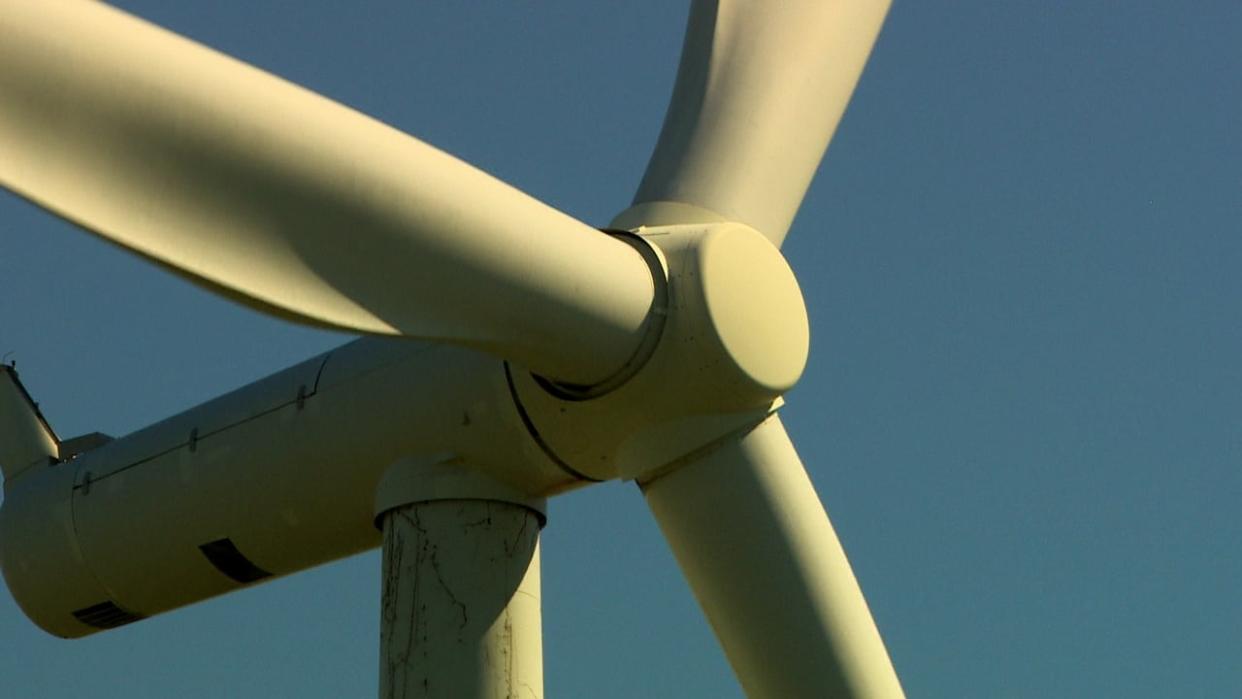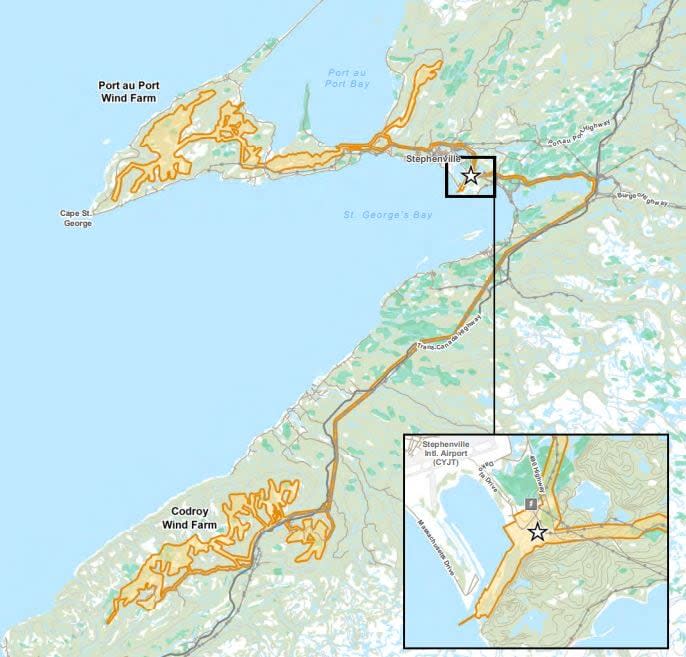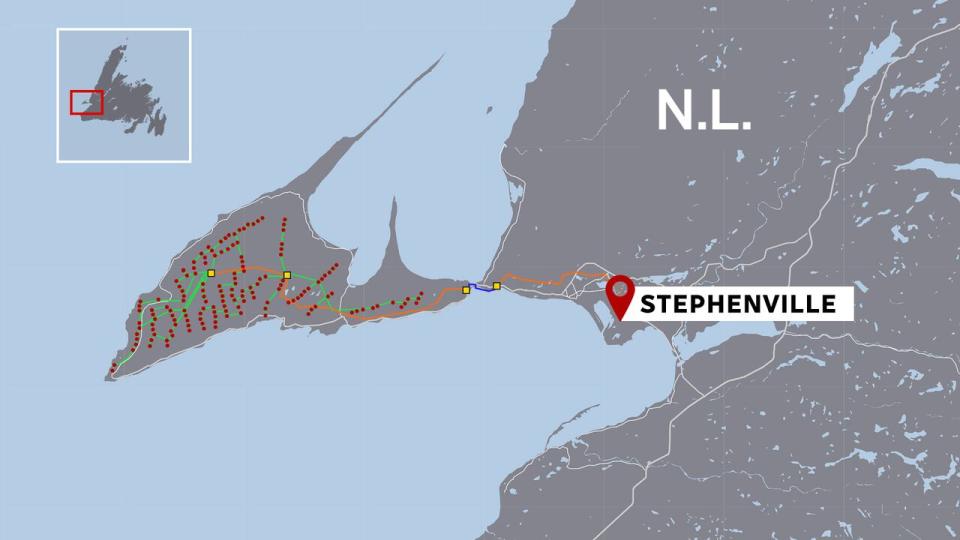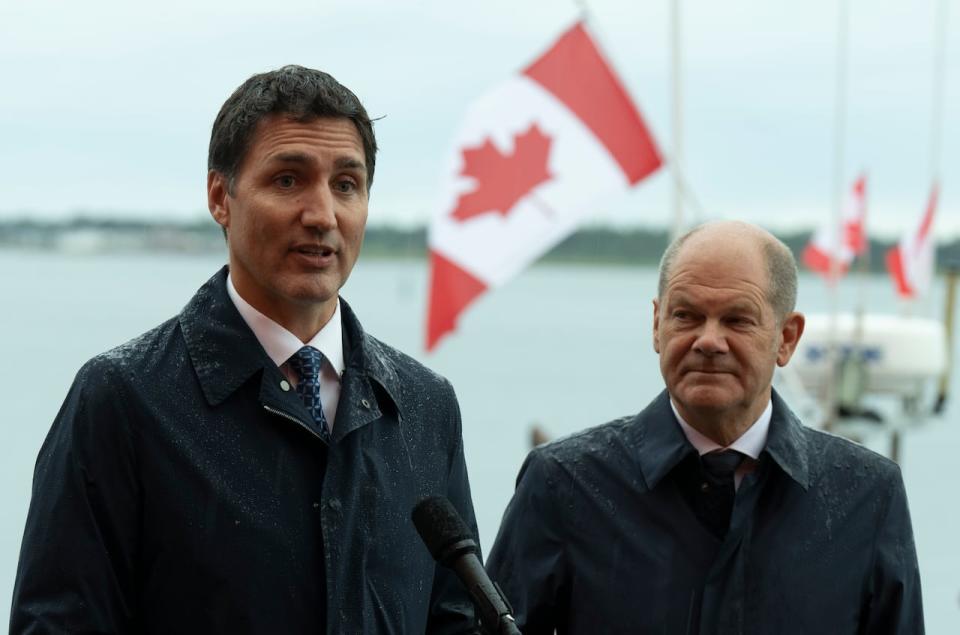Western Newfoundland wind project takes step forward with submission of environmental impact statement


Hundreds of wind turbines could crop up on Newfoundland's west coast if the World Energy GH2 project moves ahead. (CBC)
World Energy GH2 has taken another step forward with a controversial wind energy megaproject proposed for Newfoundland's west coast.
In a press release on Tuesday, the company announced it had submitted an environmental impact statement for the project, called "Nujio'qonik," which is the Mi'kmaw term for St. George's Bay and means "where the sand blows."
"This submission marks the first comprehensive environmental study in North America for a commercial-scale green hydrogen project," the company wrote.
Since its inception, the project — which will use wind turbines to create hydrogen that will then be turned into ammonia — has been met with pushback from some residents of the Port au Port Peninsula, where the biggest piece of the operation could be installed.
Hydrogen is being touted as an answer to the world's climate and energy challenges as a replacement for fossil fuels. Canada and Germany have already partnered to establish a transatlantic supply corridor, expected to start shipping hydrogen to Europe by 2025.
If all goes according to plan and the provincial government signs off on the project, World Energy GH2 expects to be producing hydrogen by the end of 2025 and ammonia in the first months of 2026.
The company outlined two sites it has in mind for the project, with the Port au Port wind farm expected to include up to 164 wind turbines and a separate wind farm in the Codroy Valley, also made up of up to 164 turbines, on Crown land in the Anguille Mountains.
Both wind farms will require a network of new and upgraded access roads to transport the project's equipment, according to the impact statement. The layouts for the wind farms and their supporting infrastructure will depend on results of the detailed field investigations.
Once the layout and number of turbines are finalized, the company writes, the models will be reviewed and updated.

This World Energy GH2 map shows the proposed scope of the company's wind farm project on Newfoundland's west coast. (World Energy GH2)
"If additional turbine locations are added to the Port au Port or Codroy wind farms in the future, it will be done in consideration of the mitigation measures, compliance with regulations, and such that the conclusions of the effects assessment do not change," says the statement.
"Development of the project will follow a phased approach, with a staggered schedule for the construction and commissioning, operation and maintenance, and decommissioning of the two wind farms and the hydrogen/ammonia plant."
Potential impacts
The company's submission includes four baseline studies: atmospheric environment, aquatic environment, terrestrial environment and socio-economic environment and land and resource use.
It hopes to begin construction — site preparation, the hydrogen-ammonia plant, storage and export facilities, wind farms, and transmission infrastructure — by the end of 2023, pending regulatory approvals.
Seventeen areas, broken into "valued environmental components" or VECs, were assessed for possible effects that could result from changes to the environment if the project goes ahead.
World Energy GH2 wrote there may be potential changes to:
Air quality.
Light.
Sound quality.
Groundwater quantity and quality.
Surface water quantity and quality.
Fish habitat quantity and quality, as well as a change in fish health and survival.
Marine habitat quantity and quality.
Marine species health and survival.
Fishing grounds and the productivity.
Wetlands diversity and function.
Bird, bat and other wildlife habitat and mortality risk.
Conservation areas.
The labour force, regional business and regional economy.
Community accommodations, infrastructure, services, transportation and well-being.
Human health, quality of life and public safety.
Designated land use.
Commercial and industrial resource use.
Indigenous commercial, food and ceremonial fisheries.
Heritage and cultural resources.

World Energy GH2 is proposing 164 wind turbines, in red, in the Port au Port Peninsula. The company has said the exact location of some turbines will change as a result of the environmental assessment process. (Kristel Mallet/Radio-Canada)
The company said cumulative environmental effects are evaluated by a two-step process that involves an initial screening and a detailed assessment as needed.
Where the contribution to cumulative effects is ranked as low, the company considers those as "minor and adequately managed by standard mitigation measures." Where they're ranked as moderate or high, the company said a more detailed assessment would be undertaken.
"The screening level assessment of potential cumulative effects conducted for the 17 VECs concludes the project's contribution to cumulative effects and overall regional cumulative effects is low (i.e., long-term sustainability of the VEC is not anticipated to be compromised and conventional project-specific mitigation remains adequate)," the statement reads.
"As such, further detailed assessment of cumulative effects is not required."
World Energy GH2 also lists a summary of its followup and monitoring programs tied to each of the 17 VECs.
They include:
An air quality management plan.
Ground and surface water monitoring plans.
Monitoring of erosion and sediment control measures and culverts for freshwater fish habitats.
Physiochemical and biological assessment of the marine sediments within the dredge footprint and ocean disposal site.
Compliance monitoring of marine discharge.
Continued vegetation and land cover classification surveys.
Additional baseline bird surveys.
Post-construction wildlife mortality monitoring.
Additional baseline bat surveys and post-construction bat mortality monitoring.
Continued baseline data programs for arctic hare, muskrat, moose and caribou.
Followup and monitoring in accordance with the project's benefits agreement, gender equity and diversity plan and workforce and employment plan.
Outfitter effects monitoring program.
A complaint reporting system.
Monitoring of ice throw events.
Domestic woodcutting consultation plan.
Traffic management plan.
Ongoing Indigenous engagement.
A heritage and cultural resources protection plan for the unplanned discovery of resources.

Prime Minister Justin Trudeau and German Chancellor Olaf Scholz met in Stephenville in August 2022 to announce a partnership between both nations for the export of hydrogen. (Adrian Wyld/The Canadian Press)
With all of that in place, western Newfoundland could be Canada's leading wind-hydrogen production site in a relatively new industry.
World Energy GH2 expects civil works associated with the Port au Port wind farm to begin in 2024, with operations starting in early 2026. The construction and operation of "temporary workforce accommodations" in Stephenville are expected to house about 1,200 to 1,500 workers during the construction of the Port au Port wind farm and the hydrogen-ammonia plant. A second temporary living site is planned to support construction of the Codroy Valley wind farm, which will house between 300 to 500 workers.
Associated storage and export facilities are scheduled to be built through mid-2024 to early 2026.
Construction of the Codroy wind farm is expected to begin in late 2025 and completed in early 2027.
The first commercial shipments of ammonia are expected to start in 2026. One or two vessels are expected to be required for shipments with an increase to four to six vessels per month for future potential development in 2028.
World Energy GH2 expects the entire project to last about 30 years, with an additional year for decommissioning for each site.
Production from the Port au Port wind farm is scheduled to end in early 2057 and production from the Codroy wind farm is scheduled to end in the summer of 2058.
Public comments about the EIS must be written and received by government by Oct. 11.
Get the news you need without restrictions. Download our free CBC News app.


